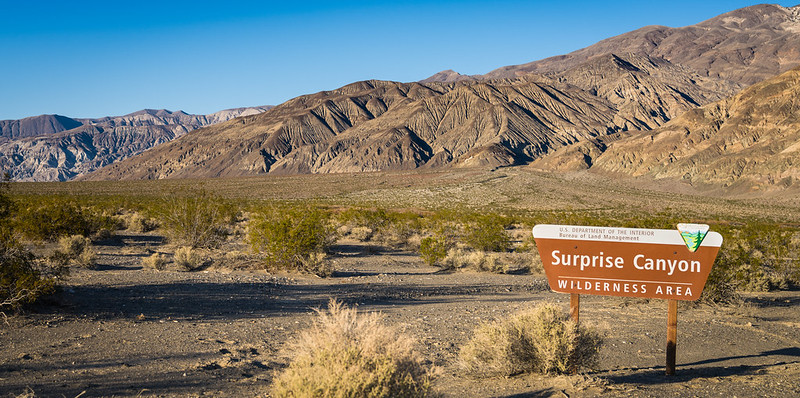Surprise Canyon Wilderness | California

Surprise Canyon Wilderness shares its entire eastern border with Death Valley National Park. It contains small alluvial slopes that gradually rise from the west into the jagged ridges and steep sides of the Panamint Mountains. Canyons cut deeply into the mountains to form the interior of the Wilderness. Old four-wheel-drive tracks crawl through Jail, Hall, and Surprise Canyons and into the park; these non-Wilderness corridors carve the area into four sections.
Elevations climb eagerly from about 1,000 feet in the west to more than 7,000 feet in the east, bestowing extraordinary vistas of the Panamint Valley from mountain summits. Creosote bush scrub and desert holly grow on alluvial fans. Cottonwoods and willows stand tall in the canyons, whose rocky walls sometimes support the rare and endangered Panamint daisy. Forests of piñon and juniper anoint the higher elevations. In addition to the views from on high, the Wilderness is graced by the lush riparian habitats of Jail, Surprise, and Happy Canyons (Happy Canyon forms the southern boundary).
If you're wondering what inspired the canyon's jaunty moniker, it stems from the "surprise" travelers experience when they stumble into the unexpected springs bubbling from the steep walls of Surprise Canyon; the springs feed a yearlong flow of water. Most of Surprise Canyon has been designated an Area of Critical Environmental Concern in order to protect wildlife (including desert bighorn sheep and Panamint alligator lizards), vegetation, and historic and cultural resources.
For more information about this wilderness, please visit Wilderness Connect.
Leave No Trace
How to follow the seven standard Leave No Trace principles differs in different parts of the country (desert vs. Rocky Mountains). For more information on any of the principles listed below, please visit Leave No Trace, Visit the Leave No Trace, Inc. website..
- Plan Ahead and Prepare
- Travel and Camp on Durable Surfaces
- Dispose of Waste Properly
- Leave What You Find
- Minimize Campfire Impacts
- Respect Wildlife
- Be Considerate of Other Visitors
Rules and Regulations
Motorized equipment and equipment used for mechanical transport are generally prohibited on all federal lands designated as wilderness. This includes the use of motor vehicles (including OHVs), motorboats, motorized equipment, bicycles, hang gliders, wagons, carts, portage wheels, and the landing of aircraft including helicopters, unless provided for in specific legislation. In a few areas some exceptions allowing the use of motorized equipment or mechanical transport are described in the special regulations in effect for a specific area. Contact the agency for more information about regulations.


